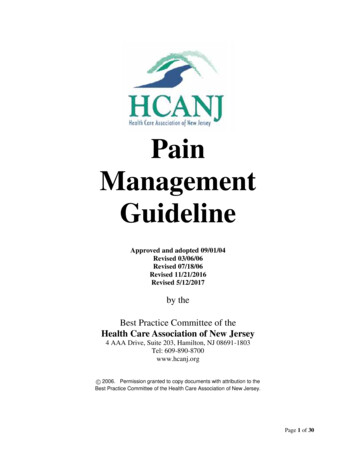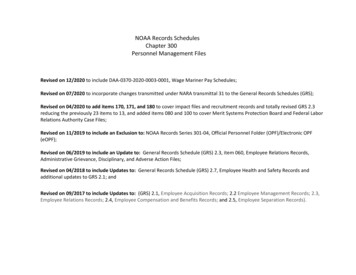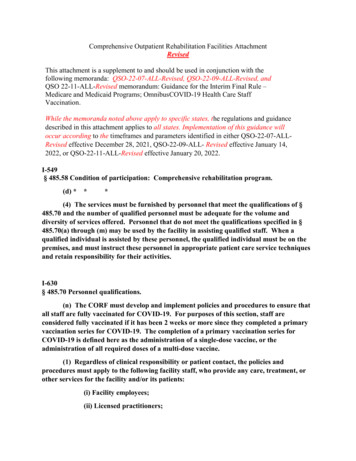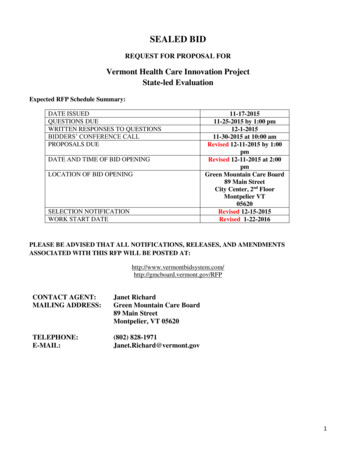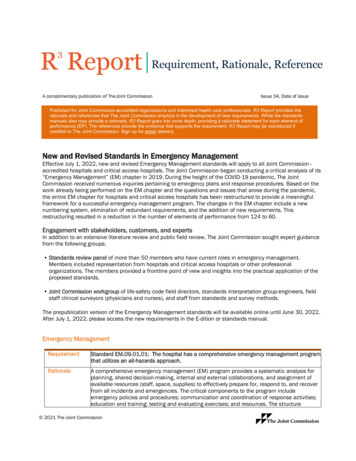
Transcription
A complimentary publication of The Joint CommissionIssue 34, Date of issuePublished for Joint Commission-accredited organizations and interested health care professionals, R3 Report provides therationale and references that The Joint Commission employs in the development of new requirements. While the standardsmanuals also may provide a rationale, R3 Report goes into more depth, providing a rationale statement for each element ofperformance (EP). The references provide the evidence that supports the requirement. R3 Report may be reproduced ifcredited to The Joint Commission. Sign up for email delivery.New and Revised Standards in Emergency ManagementEffective July 1, 2022, new and revised Emergency Management standards will apply to all Joint Commission–accredited hospitals and critical access hospitals. The Joint Commission began conducting a critical analysis of its“Emergency Management” (EM) chapter in 2019. During the height of the COVID-19 pandemic, The JointCommission received numerous inquiries pertaining to emergency plans and response procedures. Based on thework already being performed on the EM chapter and the questions and issues that arose during the pandemic,the entire EM chapter for hospitals and critical access hospitals has been restructured to provide a meaningfulframework for a successful emergency management program. The changes in the EM chapter include a newnumbering system, elimination of redundant requirements, and the addition of new requirements. Thisrestructuring resulted in a reduction in the number of elements of performance from 124 to 60.Engagement with stakeholders, customers, and expertsIn addition to an extensive literature review and public field review, The Joint Commission sought expert guidancefrom the following groups: Standards review panel of more than 50 members who have current roles in emergency management.Members included representation from hospitals and critical access hospitals or other professionalorganizations. The members provided a frontline point of view and insights into the practical application of theproposed standards. Joint Commission workgroup of life-safety code field directors, standards interpretation group-engineers, fieldstaff clinical surveyors (physicians and nurses), and staff from standards and survey methods.The prepublication version of the Emergency Management standards will be available online until June 30, 2022.After July 1, 2022, please access the new requirements in the E-dition or standards manual.Emergency ManagementRequirementStandard EM.09.01.01: The hospital has a comprehensive emergency management programthat utilizes an all-hazards approach.RationaleA comprehensive emergency management (EM) program provides a systematic analysis forplanning, shared decision-making, internal and external collaborations, and assignment ofavailable resources (staff, space, supplies) to effectively prepare for, respond to, and recoverfrom all incidents and emergencies. The critical components to the program includeemergency policies and procedures; communication and coordination of response activities;education and training; testing and evaluating exercises; and resources. The structure 2021 The Joint Commission
Issue 34, Issue datePage 2New and Revised Standards in Emergency Managementshould be designed to respond to any type of emergency (all-hazards approach) becauseof the wide array of possible emergencies and the impossibility of predicting allemergencies that could occur at an organization.Reference* RequirementRationaleReference*Centers for Medicare and Medicaid Services. (2021, April 16). State Operations ManualAppendix Z. ce/Manuals/Downloads/som107ap z emergprep.pdf.Ready.gov. (2021, February 19). Planning. https://www.ready.gov/planning.Veterans Health Administration Office of Emergency Management. (2021, May 5). U.S.Department of Veterans Affairs. https://www.va.gov.NFPA 1600: Standard on Continuity, Emergency, and Crisis Management, 2019edition.NFPA 99: Health Care Facilities Code, 2012 edition.Standard EM.10.01.01: Hospital leadership provides oversight and support of theemergency management program.The oversight of senior leaders, leaders of the medical staff, and department leaders inthe development and implementation of the EM program is necessary as they areultimately responsible for maintaining safe operations during an emergency and oftenneed to make significant and timely decisions. The identification of a qualitied EMprogram coordinator is important to ensure that critical components of the program areaddressed in the mitigation, preparedness, response, and recovery phases andintegrated throughout the organization and within the larger community responsenetwork. A multidisciplinary approach makes certain that the emergency managementprogram, the operations plan, policies and procedures, and education and traininginclude the insights across disciplines and departments. Centers for Medicare and Medicaid Services. (2021, April 16). State Operations ManualAppendix Z. ce/Manuals/Downloads/som107ap z emergprep.pdf. The American College of Healthcare Executives. (2020, November). Healthcareexecutives role in emergency management. e-in-emergencymanagement. NFPA 1600: Standard on Continuity, Emergency, and Crisis Management, 2019edition. NFPA 99: Health Care Facilities Code, 2012 edition. The Assistant Secretary for Preparedness and Response (ASPR): Technical Resources,Assistance Center, Information Exchange (TRACIE). (2021, April). Leadership during adisaster. hip-during-a-disaster.pdf.RequirementStandard EM.11.01.01: The hospital conducts a hazard vulnerability analysis utilizing anall-hazards approach.RationaleOrganizations should continually evaluate their known risks and prioritize them tounderstand their vulnerabilities and prepare to respond to emergencies. The riskassessment includes an evaluation of the natural hazards, human-caused hazards,technological hazards, hazardous materials, and emerging infectious diseases that couldimpose a significant risk to a health care organization and its off-site locations. The risksare prioritized to determine which of these presents the highest likelihood of occurringand the impacts those hazards will have on the operating status of the hospital and itsability to provide services. 2021 The Joint Commission
Issue 34, Issue dateReference*Page 3 New and Revised Standards in Emergency ManagementCenters for Medicare and Medicaid Services. (2021, April 16). State Operations ManualAppendix Z. ce/Manuals/Downloads/som107ap z emergprep.pdf.The Assistant Secretary for Preparedness and Response (ASPR): Technical Resources,Assistance Center, Information Exchange (TRACIE). (2018, October), Evaluation ofHazard Vulnerability Assessment Tools Comparison ulnerability-assessment-tools.The Centers for Disease Control and Prevention. (n.d.) Hospital all-hazards selfassessment documents/hah 508 compliant final.pdf.NFPA 1600: Standard on Continuity, Emergency, and Crisis Management, 2019edition.NFPA 99: Health Care Facilities Code, 2012 edition.RequirementStandard EM.12.01.01: The hospital develops an emergency operations plan based onan all-hazards approach.Note: The hospital considers its prioritized hazards identified as part of its hazardvulnerability assessment when developing an emergency operations plan.RationaleThe hospital’s all-hazards emergency operations plan (EOP) guides the hospital inresponding to and recovering from a variety of emergency or disaster incidents. The EOPidentifies what services the hospital will continue to provide in the event of an emergencyor disaster incident. An effective EOP also describes how the hospital leaders and staffwill do the following: Communicate and coordinate information and resources Provide staffing and clinical services Address safety and security Provide essential or critical resources to sustain operationsReference* Centers for Medicare and Medicaid Services. (2021, April 16). State Operations ManualAppendix Z. ce/Manuals/Downloads/som107ap z emergprep.pdf. California Hospital Association. (n.d.). Emergency preparedness: Preparing hospitals fordisaster. tions-plan. NFPA 1600: Standard on Continuity, Emergency, and Crisis Management, 2019edition. NFPA 99: Health Care Facilities Code, 2012 edition. California Hospital Association. (n.d). Emergency management principles and practicesfor healthcare systems. ems.RequirementStandard EM.12.02.01: The hospital has a communications plan that addresses how itwill initiate and maintain communications during an emergency.Note: The hospital considers prioritized hazards identified as part of its hazardvulnerability analysis when developing a communications plan.An effective hospital communications plan describes how and when it will communicateinformation to its staff, other health care organizations, community partners (such as,fire, police, local incident command, public health departments) and relevant authorities(federal, state, tribal, regional, and local emergency preparedness staff). Thecommunications plan should account for the rapid evolution of an emergency or disasterand the need to consistently provide clear information regarding the emergency and thehospital’s ability to provide services both internally and externally. The resources andtools used for maintaining communications (primary or alternate means) are a criticalelement of disaster preparedness.Rationale 2021 The Joint Commission
Issue 34, Issue dateReference*Page 4 New and Revised Standards in Emergency ManagementCenters for Medicare and Medicaid Services. (2021, April 16). State Operations ManualAppendix Z. ce/Manuals/Downloads/som107ap z emergprep.pdf.California Hospital Association. (2021, February) Emergency Preparedness: Preparinghospitals for disaster. ility-analysis.NFPA 1600: Standard on Continuity, Emergency, and Crisis Management, 2019edition.NFPA 99: Health Care Facilities Code, 2012 edition.United States Agency for International Development. (n.d.). Communications planningfor hospitals. https://pdf.usaid.gov/pdf docs/PA00JW4F.pdf.American Hospital Association. (2020, October). Communications: Internal and rnal.pdf.RequirementStandard EM.12.02.03: The hospital has a staffing plan for managing all staff andvolunteers during an emergency or disaster incident.Note: The hospital considers its prioritized hazards identified as part of its hazardvulnerability analysis when developing a staffing plan.RationaleWhen the hospital activates its emergency operations plan (EOP) in response to anemergency or disaster, it may find that it is unable to meet or maintain the immediateneeds of its patients. Hospitals should anticipate staffing shortages and be prepared toobtain staff from within their health care system, staffing agencies, or those who arefederally deployed as part of disaster medical assistance teams. Hospitals should alsomeet the needs of the health care staff by supporting their emotional and mental healthneeds during an emergency or disaster. Centers for Medicare and Medicaid Services. (2021, April 16). State Operations ManualAppendix Z. ce/Manuals/Downloads/som107ap z emergprep.pdf. California Hospital Association. (n.d.). Emergency preparedness: Preparing hospitals fordisaster. https://www.calhospitalprepare.org/volunteers. NFPA 1600: Standard on Continuity, Emergency, and Crisis Management, 2019edition. NFPA 99: Health Care Facilities Code, 2012 edition. The Assistant Secretary for Preparedness and Response (ASPR): Technical Resources,Assistance Center, Information Exchange (TRACIE). (2018, September). Tips for retainingand caring for staff after a disaster. . American Nurses Association. (2017). Who will be there? Ethics, the law, and a nurse’sduty to respond in a disaster.https://www.nursingworld.org/ re disaster-preparedness 2017.pdf. American College of Emergency Physicians. (2017). Policy statement: hospital disasterphysician privileging. s/hospitaldisaster-physician-privileging/. United States Department of Veterans Affairs. (2012). VHA handbook: credentialingand wPublication.asp?pub ID 2815. The Assistant Secretary for Preparedness and Response (ASPR): Technical Resources,Assistance Center, Information Exchange (TRACIE). (n.d.). Volunteer sources/74/volunteer-management/74.Reference* 2021 The Joint Commission
Issue 34, Issue datePage 5New and Revised Standards in Emergency ManagementRequirementStandard EM.12.02.05: The hospital has a plan for providing patient care and clinicalsupport during an emergency or disaster incident.Note: The hospital considers its prioritized hazards identified as part of its hazardvulnerability analysis when developing a plan for patient care and clinical support.RationaleA well-thought-out plan that maintains a hospital’s ability to provide critical servicesduring emergencies or disasters can be a matter of life and death for its patients andthe community it serves. Planning for patient clinical support focuses on equipment andresources that play a direct role in an incident response. The hospital’s emergencyoperations plan addresses patient care and clinical support activities, including transferplans, continuity of care, and rapid acquisition of patient care supplies and health carerecords, especially when evacuation is imminent.Reference* Centers for Medicare and Medicaid Services. (2021, April 16). State OperationsManual Appendix Z. ce/Manuals/Downloads/som107ap z emergprep.pdf. World Health Organization. Making health facilities safe in emergencies and alth-facilities-safe-in-emergencies-anddisasters. NFPA 99: Health Care Facilities Code, 2012 edition. The Assistant Secretary for Preparedness and Response (ASPR): Technical Resources,Assistance Center, Information Exchange (TRACIE). (n.d.). Innovations in COVID-19patient surge management. .pdf.RequirementStandard EM.12.02.07: The hospital has a plan for safety and security measures totake during an emergency or disaster incident.Note: The hospital considers its prioritized hazards identified as part of its hazardvulnerability analysis when developing a plan for safety and security.RationaleEmergencies and disasters often create new and rapidly changing safety and securityconcerns. An emergency response plan should include the possible need forheightening security measures; tracking and accountability of patients, staff, andfamilies; and minimizing exposures to hazards. Safety and security measures includepartnering with community security agencies (for example, police, sheriff, NationalGuard) and coordinating security activities that may be outside the span of control of thehospital’s security team. Centers for Medicare and Medicaid Services. (2021, April 16). State OperationsManual Appendix Z. ce/Manuals/Downloads/som107ap z emergprep.pdf. NFPA 1600: Standard on Continuity, Emergency, and Crisis Management, 2019edition. NFPA 99: Health Care Facilities Code, 2012 edition.Reference*RequirementStandard EM.12.02.09: The hospital has a plan for managing resources and assetsduring an emergency or disaster incident.Note: The hospital considers its prioritized hazards identified as part of its hazardvulnerability analysis when developing a plan for resources and assets.RationaleAccess to resources can often be difficult when the needs in a community or region isgreater than what is available locally; therefore, the hospital’s plan includes continualassessment on how to obtain, allocate, mobilize, replenish, and conserve its resourcesand assets during and after an emergency or disaster incident. 2021 The Joint Commission
Issue 34, Issue datePage 6New and Revised Standards in Emergency ManagementReference* Centers for Medicare and Medicaid Services. (2021, April 16). State OperationsManual Appendix Z. ce/Manuals/Downloads/som107ap z emergprep.pdf. NFPA 1600: Standard on Continuity, Emergency, and Crisis Management, 2019edition. NFPA 99: Health Care Facilities Code, 2012 edition. Centers for Disease Control and Prevention and American Water Works Association.(2019). Emergency water supply planning guide for hospitals and healthcare 508.pdf. Ready.gov. (2021, May 26). Resource Management. https://www.ready.gov/resourcemanagement. Centers for Disease Control and Prevention. (2016, February 3). Federal resources forplanning. gpreparedness/federal-government-planning.html. The Assistant Secretary for Preparedness and Response (ASPR): Technical Resources,Assistance Center, Information Exchange (TRACIE). (2019, August). Partnering with thehealthcare supply chain during a -chain-during-disasters.pdf.RequirementStandard EM.12.02.11: The hospital has a plan for managing essential or criticalutilities during an emergency or disaster incident.Note: The hospital considers its prioritized hazards identified as part of its hazardvulnerability analysis when developing a plan for utilities management.RationaleEmergencies or disasters often have a detrimental impact on hospitals’ utility system(s),including loss of the system(s). The list of essential or critical systems that couldpotentially fail during an emergency can range from heating, ventilation, and airconditioning; network connectivity; and refrigeration equipment. The hospital must beprepared with alternate ways in which it will provide essential or critical systems tomaintain functional operations.Reference* Centers for Medicare and Medicaid Services. (2021, April 16). State OperationsManual Appendix Z. ce/Manuals/Downloads/som107ap z emergprep.pdf. NFPA 1600: Standard on Continuity, Emergency, and Crisis Management, 2019edition. NFPA 99: Health Care Facilities Code, 2012 edition. National Fire ProtectionAssociation (NFPA ) 99 (2012). Health Care Facilities Code. The Federal Emergency Management Agency (FEMA) and the U.S. Department ofHealth and Human Services (HHS) Office of the Assistant Secretary for Preparednessand Response (ASPR) (2019). Healthcare facilities and power outages: Guidance forstate, local, tribal, territorial, and private sector RequirementStandard EM.13.01.01: The hospital has a continuity of operations plan.Note: The hospital considers its prioritized hazards identified as part of its hazardvulnerability assessment when developing a continuity of operations plan. 2021 The Joint Commission
Issue 34, Issue datePage 7New and Revised Standards in Emergency ManagementRationaleThe continuity of operations plan (COOP) provides guidance on how the organization willcontinue to perform its essential business functions, deliver essential services, anddelegation of authority and succession plans when there has been a disruption tonormal operations. The hospital’s executive leadership identifies and prioritizes thoseessential services that are deemed necessary to remain operational and makes certainthat critical business functions continue working during an emergency or disasterincident. The executive leaders consider costs associated with acceptable andunacceptable levels of risk and prioritize where and when to focus resources, funding,and other assets.Reference* Centers for Medicare and Medicaid Services. (2021, April 16). State OperationsManual Appendix Z. ce/Manuals/Downloads/som107ap z emergprep.pdf. NFPA 1600: Standard on Continuity, Emergency, and Crisis Management, 2019edition. NFPA 99: Health Care Facilities Code, 2012 edition. California Hospital Association. (n.d.). Emergency Preparedness: Preparing hospitalsfor disaster. ning. The American College of Healthcare Executives. (2020, November). Healthcareexecutives role in emergency management. e-in-emergencymanagement.RequirementStandard EM.14.01.01: The hospital has a disaster recovery plan.Note: The hospital considers its prioritized hazards identified as part of its hazardvulnerability assessment when developing a disaster recovery plan.RationaleDisaster recovery strategies focus on how and when the hospital will return to fullfunctionality after an emergency or disaster. This includes proactively developing adisaster recovery plan, utilizing the hazard’s vulnerability analysis, identifying the criticalsystems such as electricity, water, communications, and information technology neededto return to full operations. The disaster recovery plan also addresses how familyreunification and identification of adults and unaccompanied children will occur.Reference* Centers for Medicare and Medicaid Services. (2021, April 16). State OperationsManual Appendix Z. ce/Manuals/Downloads/som107ap z emergprep.pdf. NFPA 1600: Standard on Continuity, Emergency, and Crisis Management, 2019edition. NFPA 99: Health Care Facilities Code, 2012 edition. California Hospital Association. (n.d.). Emergency preparedness: Preparing hospitalsfor disaster. ementStandard EM.15.01.01: The hospital has an emergency management education andtraining program.Note: The hospital considers its prioritized hazards identified as part of its hazardvulnerability assessment when developing education and training.RationaleOrganizations should use their known risks, emergency operations plan, policies andprocedures, and communications plan as a basis for developing an education andtraining program. Disaster response requires a unique set of capabilities related toknowledge and skills. The program provides disaster-related knowledge and training forits staff, individuals providing services under arrangement, volunteers, physicians, andother licensed practitioners that is consistent with their roles and responsibilities in anemergency. This provides a foundation for those assigned to disaster roles to functionefficiently and effectively during an emergency or disaster incident. 2021 The Joint Commission
Issue 34, Issue datePage 8New and Revised Standards in Emergency ManagementReference* Centers for Medicare and Medicaid Services. (2021, April 16). State OperationsManual Appendix Z. ce/Manuals/Downloads/som107ap z emergprep.pdf. NFPA 1600: Standard on Continuity, Emergency, and Crisis Management, 2019edition. NFPA 99: Health Care Facilities Code, 2012 edition. California Hospital Association. (n.d.). Emergency preparedness: Preparing hospitalsfor disaster. resources. Florida Department of Health. (2011). Recommended disaster core competencies forhospital personnel. /emergencypreparedness-and-response/ tandard EM.16.01.01: The hospital plans and conducts exercises to test itsemergency operations plan and response procedures.Note: The hospital considers its prioritized hazards identified as part of its hazardvulnerability assessment when developing emergency exercises.RationaleExercises are conducted to test the emergency operations plan through discussionbased or operations-based exercises. These exercises should be comprehensiveenough to test the hospital’s emergency plans and response capabilities to failure andincorporate the six critical areas (communications, resources and assets, staffing,patient care activities, utilities, safety and security). Hospitals that participate withcommunity partners during such exercises can establish common goals to betterrespond to emergencies or disasters, including the sharing of resources or theidentification of alternative care sites.Reference* Centers for Medicare and Medicaid Services. (2021, April 16). State OperationsManual Appendix Z. ce/Manuals/Downloads/som107ap z emergprep.pdf. NFPA 1600: Standard on Continuity, Emergency, and Crisis Management, 2019edition. NFPA 99: Health Care Facilities Code, 2012 edition. U.S. Department of Homeland Security (2020). Homeland security exercise andevaluation program. eparedness/exercises/hseep.RequirementStandard EM.17.01.01: The hospital evaluates its emergency management program,emergency operations, and continuity of operations plans.Hospitals that evaluate each event or exercise are better prepared for emergenciesbecause they often find unknown risks or failures through these reviews. It is importantto then update the emergency management program and emergency operations plan tocorrect these deficiencies. Improving the plan makes it more effective at sustainingcritical operations and protecting lives. Centers for Medicare and Medicaid Services. (2021, April 16). State OperationsManual Appendix Z. ce/Manuals/Downloads/som107ap z emergprep.pdf. NFPA 1600: Standard on Continuity, Emergency, and Crisis Management, 2019edition. NFPA 99: Health Care Facilities Code, 2012 edition.RationaleReference**Not a complete literature review. 2021 The Joint Commission
Issue 34, Issue datePage 9New and Revised Standards in Emergency ManagementA special thanks to the following contributors:Standards Review Panel (SRP) MembersEric Alberts, CEM, CHPP, CEDP, CHEP, FPEM, FPEM-HC, SEM/B.S.Denise Bechard, MSDM, BEM, CHEC IIJames Bernardo, U.S. Navy, Medical Emergency ManagerGeorgina Birko-Burris, MBA, CHSP, CHEPRyan Bonacci, Chief of PoliceDon R. Boyce, JDPete Brewster, BS, CPM,Benjamin Brooks, BSN, RNThomas Calimano, NHDP-BC, CEMJason Campbell, MPH, CEMRobert Carter, MSN, RN, CFRN, CPEN, NRPTracy Case, RN, BSNScott Cormier, BS, CHEP, NRPFred Craigin, MPSATroy Erbentraut, BS, EMT-B, CHEC II, CHPCPThomas J. Flanagan, RN, BSN, MA, LPCassandra Grace, MSHSToby Hatton, MA, BSN, BSJohn Hick, MDJames Thomas Hosack, APRN, MSN, MA, BSN, RNLois Husted, BSNMelissa Jackson, DHA, MS, BSHARichard Johnson, MSEMKristin Kearns, MPAStephanie Kuschel, MPA, BS, EMTBrent Lewis, CHSP, FF, EMTFreda Lyon, DNP, RN, NE-BC, FAENJeff Mangrum, RN, BS, MHA, CHEPBen Mance, CHSPKevin Martin, CPP, CHEP, CHSP, HEM/BAKelly R. McKinney, CBCP, PEDavid Miller, Jr., MPH, CPH, CEM, CHSO, NHDP-BC, NYS-EMC, EMT-B, FRSPHRachel Mockros, MBAHazel Philbert, BS, BSN, MBA, MSHS, RN, CPHQJeff Pigg, BSJoseph Powell, MBA, CHSP, MLT(ASCP)cmJennifer Price, MSHS, BSN, RNCathleen Shanahan, RN, MS, BSN, MBA, NE-BCJared Shapiro, DrPH(c), PhD(c), MPH, CEM, HEM, FAcEM, CHSP, CHFM, NRPJim Skipper, RN, MSNMichael W. Stephens, BSSteven Storbakken, MBA, CHEP, CHSP, CHEM, CHPA, HACP, CHPPDarren VanBlaircomRobert Voliva, BS, CHSP, CHEP, CHECKay Vonderschmidt, Paramedic (NRP), CEM, MPA, MSEM, D.Sc.Mike Wargo, BSN, MBA, PHRN, CMT-EThomas WhitehurstThe Joint Commission’s Emergency Management WorkgroupAngela Murray, MSN, RN, Project Director, Department of Standards and Survey MethodsLaura Smith, M.A, Project Director, Department of Standards and Survey MethodsTabitha Vieweg, MBA, BSN, RN, Associate Director, Department of Standards and Survey Methods 2021 The Joint Commission
Issue 34, Issue datePage 10New and Revised Standards in Emergency ManagementMamello K. Tekateka, MBA, Senior Research Associate, Department of ResearchJim Kendig, MS, CHSP, HEM, Field Director, Surveyor Management and SupportTim Markijohn, MBA\MHA, CHFM, CHE, Field Director, Surveyor Management and SupportMarisa Voelkel, RN, MBA, CHSP, CHEP, Associate Director, SIG/Department of EngineeringKenneth “Beau” Hebert Jr., MAOM, CHSP, CHEP, Associate Director, SIG/Department of EngineeringHerman A. McKenzie, MBA, CHSP, Director, SIG/Department of EngineeringDr. James Fasules, FACC FAAP, Hospital Program Physician Surveyor, Surveyor Management and SupportAntonette Silvestri, MSN, APRN, Hospital Program Nurse Surveyor, Surveyor Management and SupportDr. Lewis Soloff, Hospital Program Physician Surveyor (retired), Surveyor Management and Support 2021 The Joint Commission
Note: The hospital considers its prioritized hazards identified as part of its hazard vulnerability assessment when developing an emergency operations plan. Rationale The hospital's all-hazards emergency operations plan (EOP) guides the hospital in responding to and recovering from a variety of emergency or disaster incidents. The EOP
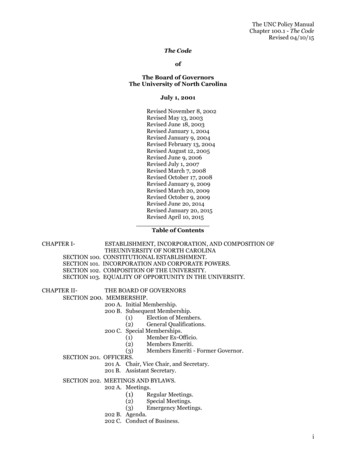


![firearms qualifications [PFP#730045656]](/img/59/firearms2003.jpg)

